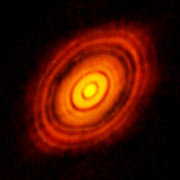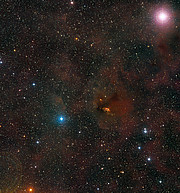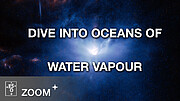Press Release
Astronomers reveal a new link between water and planet formation
29 February 2024
Researchers have found water vapour in the disc around a young star exactly where planets may be forming. Water is a key ingredient for life on Earth, and is also thought to play a significant role in planet formation. Yet, until now, we had never been able to map how water is distributed in a stable, cool disc — the type of disc that offers the most favourable conditions for planets to form around stars. The new findings were made possible thanks to the Atacama Large Millimeter/submillimeter Array (ALMA), in which the European Southern Observatory (ESO) is a partner.
“I had never imagined that we could capture an image of oceans of water vapour in the same region where a planet is likely forming,” says Stefano Facchini, an astronomer at the University of Milan, Italy, who led the study published today in Nature Astronomy. The observations reveal at least three times as much water as in all of Earth’s oceans in the inner disc of the young Sun-like star HL Tauri, located 450 light-years away from Earth in the constellation Taurus.
“It is truly remarkable that we can not only detect but also capture detailed images and spatially resolve water vapour at a distance of 450 light-years from us ,” adds co-author Leonardo Testi, an astronomer at the University of Bologna, Italy. The ‘spatially resolved’ observations with ALMA allow astronomers to determine the distribution of water in different regions of the disc. “Taking part in such an important discovery in the iconic HL Tauri disc was beyond what I had ever expected for my first research experience in astronomy,” adds Mathieu Vander Donckt from the University of Liège, Belgium, who was a master’s student when he participated in the research.
A significant amount of water was found in the region where a known gap in the HL Tauri disc exists. Ring-shaped gaps are carved out in gas- and dust-rich discs by orbiting young planet-like bodies as they gather up material and grow. “Our recent images reveal a substantial quantity of water vapour at a range of distances from the star that include a gap where a planet could potentially be forming at the present time,” says Facchini. This suggests that this water vapour could affect the chemical composition of planets forming in those regions.
Observing water with a ground-based telescope is no mean feat as the abundant water vapour in Earth’s atmosphere degrades the astronomical signals. ALMA, operated by ESO together with its international partners, is an array of telescopes in the Chilean Atacama Desert at about 5000 metres elevation that was built in a high and dry environment specifically to minimise this degradation, providing exceptional observing conditions. “To date, ALMA is the only facility able to spatially resolve water in a cool planet-forming disc,” says co-author Wouter Vlemmings, a professor at the Chalmers University of Technology in Sweden [1].
“It is truly exciting to directly witness, in a picture, water molecules being released from icy dust particles,” says Elizabeth Humphreys, an astronomer at ESO who also participated in the study. The dust grains that make up a disc are the seeds of planet formation, colliding and clumping into ever larger bodies orbiting the star. Astronomers believe that where it is cold enough for water to freeze onto dust particles, things stick together more efficiently — an ideal spot for planet formation. “Our results show how the presence of water may influence the development of a planetary system, just like it did some 4.5 billion years ago in our own Solar System,” Facchini adds.
With upgrades happening at ALMA and ESO’s Extremely Large Telescope (ELT) coming online within the decade, planet formation and the role water plays in it will become clearer than ever. In particular METIS, the Mid-infrared ELT Imager and Spectrograph, will give astronomers unrivalled views of the inner regions of planet-forming discs, where planets like Earth form.
Notes
[1] The new observations used the Band 5 and Band 7 receivers on ALMA. Bands 5 and 7 were European developments, at Chalmers/NOVA (Netherlands Research School for Astronomy) and IRAM (Institut de radioastronomie millimétrique), respectively, with involvement of ESO. Band 5 expanded ALMA into a new frequency range specifically for detecting and imaging water in the local Universe. In this study, the team observed three spectral lines of water across the two receiver frequency ranges to map gas at different temperatures within the disc.
More information
This research was presented in a paper titled “Resolved ALMA observations of water in the inner astronomical units of the HL Tau disk” to appear in Nature Astronomy (doi:10.1038/s41550-024-02207-w).
The team is composed of S. Facchini (Dipartimento di Fisica, Università degli Studi di Milano, Italy), L. Testi (Dipartimento di Fisica e Astronomia “Augusto Righi”, Università di Bologna, Italy), E. Humphreys (European Southern Observatory, Germany, Joint ALMA Observatory, Chile; European Southern Observatory Vitacura, Chile), M. Vander Donckt (Space sciences, Technologies & Astrophysics Research (STAR) Institute, University of Liège, Belgium), A. Isella (Department of Physics and Astronomy, Rice University, USA [Rice]), R. Wrzosek (Rice), A. Baudry (Laboratoire d’Astrophysique de Bordeaux, Univ. de Bordeaux, CNRS, France), M. D. Gray (National Astronomical Research Institute of Thailand, Thailand), A. M. S. Richards (JBCA, University of Manchester, UK), W. Vlemmings (Department of Space, Earth and Environment, Chalmers University of Technology, Sweden).
The Atacama Large Millimeter/submillimeter Array (ALMA), an international astronomy facility, is a partnership of ESO, the U.S. National Science Foundation (NSF) and the National Institutes of Natural Sciences (NINS) of Japan in cooperation with the Republic of Chile. ALMA is funded by ESO on behalf of its Member States, by NSF in cooperation with the National Research Council of Canada (NRC) and the National Science and Technology Council (NSTC) in Taiwan and by NINS in cooperation with the Academia Sinica (AS) in Taiwan and the Korea Astronomy and Space Science Institute (KASI). ALMA construction and operations are led by ESO on behalf of its Member States; by the National Radio Astronomy Observatory (NRAO), managed by Associated Universities, Inc. (AUI), on behalf of North America; and by the National Astronomical Observatory of Japan (NAOJ) on behalf of East Asia. The Joint ALMA Observatory (JAO) provides the unified leadership and management of the construction, commissioning and operation of ALMA.
Links
- Research paper (pre-print version, with provisional title)
- Photos of ALMA
- Find out more about ESO's Extremely Large Telescope on our dedicated website and press kit
- For journalists: subscribe to receive our releases under embargo in your language
- For scientists: got a story? Pitch your research
Contacts
Stefano Facchini
University of Milan
Milan, Italy
Tel: +39 02 503 17254
Email: stefano.facchini@unimi.it
Elizabeth Humphreys
European Southern Observatory
Garching bei München, Germany
Tel: +49 89 3200 6541
Email: ehumphre@eso.org
Leonardo Testi
University of Bologna
Bologna, Italy
Tel: +39 051 20 9 5763
Email: leonardo.testi@unibo.it
Mathieu Vander Donckt
University of Liege
Liege, Belgium
Tel: +32 4 366 9721
Email: Mathieu.VanderDonckt@uliege.be
Wouter Vlemmings
Chalmers University of Technology
Gothenburg, Sweden
Tel: +46 31 772 63 54
Email: wouter.vlemmings@chalmers.se
Bárbara Ferreira
ESO Media Manager
Garching bei München, Germany
Tel: +49 89 3200 6670
Cell: +49 151 241 664 00
Email: press@eso.org






